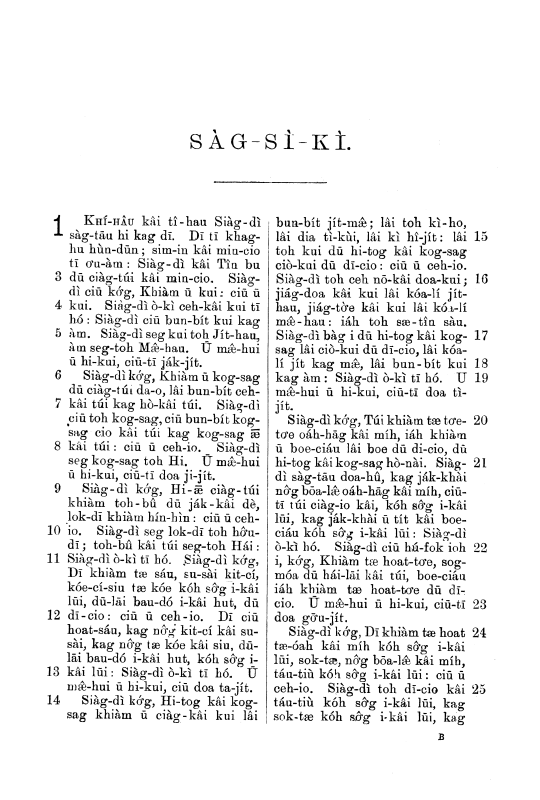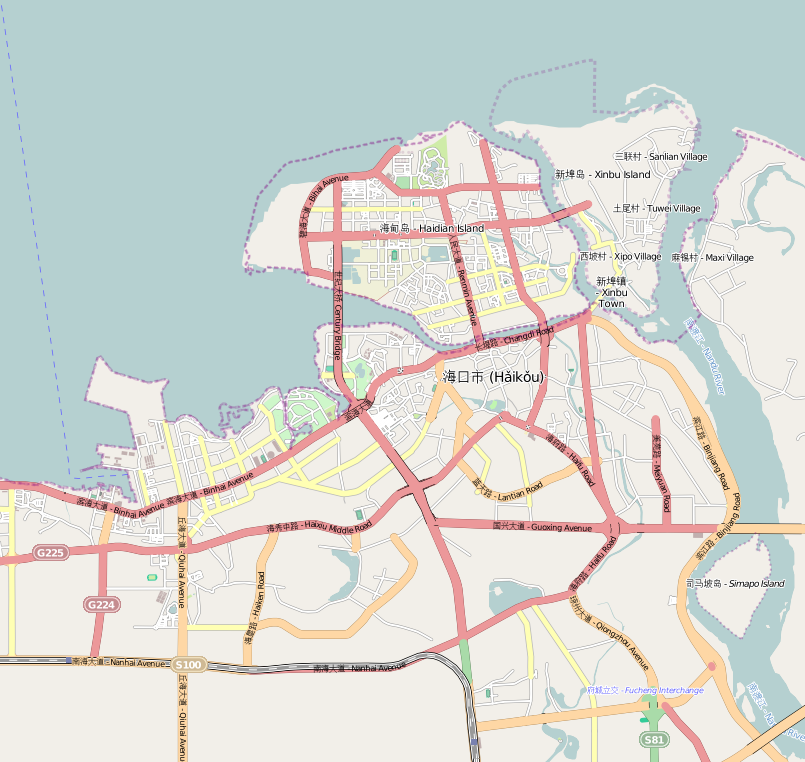|
Hainan Romanised
Hainanese Romanized, also known as its local name Bǽh-oe-tu (白話字), is an orthography similar to Pe̍h-oē-jī, and used to write Haikou dialect of the Hainanese language. It was invented by Carl C. Jeremiassen, a Danish pioneer missionary in Fucheng (modern Haikou) in 1881. Spelling schemes Consonants Vowels Tones Sample texts from Hainanese Bibles File:HainanBible1.gif File:HainaneseBible2.gif File:HainaneseBible3.gif File:HainaneseBible4.gif See also *Hainanese Transliteration Scheme The Hainanese Transliteration Scheme () refers to a romanization scheme published by the Guangdong Provincial Education Department in September 1960 as one of four systems collectively referred to as Guangdong Romanization. The scheme describes t ... ({{lang, zh, 海南话拼音方案) Hainan Min Latin-script orthographies Romanization of Chinese ... [...More Info...] [...Related Items...] OR: [Wikipedia] [Google] [Baidu] |
Latin Alphabet
The Latin alphabet or Roman alphabet is the collection of letters originally used by the ancient Romans to write the Latin language. Largely unaltered with the exception of extensions (such as diacritics), it used to write English and the other modern European languages. With modifications, it is also used for other alphabets, such as the Vietnamese alphabet. Its modern repertoire is standardised as the ISO basic Latin alphabet. Etymology The term ''Latin alphabet'' may refer to either the alphabet used to write Latin (as described in this article) or other alphabets based on the Latin script, which is the basic set of letters common to the various alphabets descended from the classical Latin alphabet, such as the English alphabet. These Latin-script alphabets may discard letters, like the Rotokas alphabet, or add new letters, like the Danish and Norwegian alphabets. Letter shapes have evolved over the centuries, including the development in Medieval Latin of lower-case, fo ... [...More Info...] [...Related Items...] OR: [Wikipedia] [Google] [Baidu] |
Haikou Dialect
The Haikou dialect is a topolect of Chinese and a subvariety of Hainanese spoken in Haikou, the capital of the Hainan province and island of China. Phonology The Haikou dialect has the following initials: The finals are: There are also two syllabic nasals, /m̩/ and /ŋ̍/. The tone categories (described using Chao tone letters) are: See also * Hainan Romanized Hainanese Romanized, also known as its local name Bǽh-oe-tu (白話字), is an orthography similar to Pe̍h-oē-jī, and used to write Haikou dialect of the Hainanese language. It was invented by Carl C. Jeremiassen, a Danish pioneer missi ... References Sources * * {{st-lang-stub Hainan Min ... [...More Info...] [...Related Items...] OR: [Wikipedia] [Google] [Baidu] |
Hainanese
Hainanese (Hainan Romanised: ', Hainanese Pinyin: ',), also known as Qióngwén, Heng2 vun2 () or Qióngyǔ, Heng2 yi2 (), is a group of Min Chinese varieties spoken in the southern Chinese island province of Hainan and Overseas Chinese such as Malaysia. In the classification of Yuan Jiahua, it was included in the Southern Min group, being mutually unintelligible with other Southern Min varieties such as Hokkien–Taiwanese and Teochew. In the classification of Li Rong, used by the ''Language Atlas of China'', it was treated as a separate Min subgroup. Hou Jingyi combined it with Leizhou Min, spoken on the neighboring mainland Leizhou Peninsula, in a Qiong–Lei group. "Hainanese" is also used for the language of the Li people living in Hainan, but generally refers to Min varieties spoken in Hainan. Phonology Hainanese has seven phonemic vowels . Hainanese notably has a series of implosive consonants, which it acquired through contact with surrounding languages, ... [...More Info...] [...Related Items...] OR: [Wikipedia] [Google] [Baidu] |
Carl C
Carl may refer to: *Carl, Georgia, city in USA *Carl, West Virginia, an unincorporated community *Carl (name), includes info about the name, variations of the name, and a list of people with the name *Carl², a TV series * "Carl", an episode of television series ''Aqua Teen Hunger Force'' * An informal nickname for a student or alum of Carleton College CARL may refer to: *Canadian Association of Research Libraries *Colorado Alliance of Research Libraries See also *Carle (other) *Charles *Carle, a surname *Karl (other) *Karle (other) Karle may refer to: Places * Karle (Svitavy District), a municipality and village in the Czech Republic * Karli, India, a town in Maharashtra, India ** Karla Caves, a complex of Buddhist cave shrines * Karle, Belgaum, a settlement in Belgaum d ... {{disambig ja:カール zh:卡尔 ... [...More Info...] [...Related Items...] OR: [Wikipedia] [Google] [Baidu] |
Pe̍h-ōe-jī
(; ; ), also sometimes known as the Church Romanization, is an orthography used to write variants of Southern Min Chinese, particularly Taiwanese and Amoy Hokkien. Developed by Western missionaries working among the Chinese diaspora in Southeast Asia in the 19th century and refined by missionaries working in Xiamen and Tainan, it uses a modified Latin alphabet and some diacritics to represent the spoken language. After initial success in Fujian, POJ became most widespread in Taiwan and, in the mid-20th century, there were over 100,000 people literate in POJ. A large amount of printed material, religious and secular, has been produced in the script, including Taiwan's first newspaper, the '' Taiwan Church News''. During Taiwan under Japanese rule (1895–1945), the use of was suppressed and Taiwanese kana encouraged; it faced further suppression during the Kuomintang martial law period (1947–1987). In Fujian, use declined after the establishment of the People's Republic of ... [...More Info...] [...Related Items...] OR: [Wikipedia] [Google] [Baidu] |
Book Of Genesis
The Book of Genesis (from Greek ; Hebrew: בְּרֵאשִׁית ''Bəreʾšīt'', "In hebeginning") is the first book of the Hebrew Bible and the Christian Old Testament. Its Hebrew name is the same as its first word, ( "In the beginning"). Genesis is an account of the creation of the world, the early history of humanity, and of Israel's ancestors and the origins of the Jewish people. Tradition credits Moses as the author of Genesis, as well as the books of Exodus, Leviticus, Numbers and most of Deuteronomy; however, modern scholars, especially from the 19th century onward, place the books' authorship in the 6th and 5th centuries BC, hundreds of years after Moses is supposed to have lived.Davies (1998), p. 37 Based on scientific interpretation of archaeological, genetic, and linguistic evidence, most scholars consider Genesis to be primarily mythological rather than historical. It is divisible into two parts, the primeval history (chapters 1–11) and the ancestr ... [...More Info...] [...Related Items...] OR: [Wikipedia] [Google] [Baidu] |
Danish People
Danes ( da, danskere, ) are a North Germanic ethnic group and nationality native to Denmark and a modern nation identified with the country of Denmark. This connection may be ancestral, legal, historical, or cultural. Danes generally regard themselves as a nationality and reserve the word "ethnic" for the description of recent immigrants, sometimes referred to as "new Danes". The contemporary Danish national identity is based on the idea of "Danishness", which is founded on principles formed through historical cultural connections and is typically not based on racial heritage. History Early history Denmark has been inhabited by various Germanic peoples since ancient times, including the Angles, Cimbri, Jutes, Herules, Teutones and others. The first mentions of " Danes" are recorded in the mid-6th century by historians Procopius ( el, δάνοι) and Jordanes (''danī''), who both refer to a tribe related to the Suetidi inhabiting the peninsula of Jutland, the province of Sc ... [...More Info...] [...Related Items...] OR: [Wikipedia] [Google] [Baidu] |
Haikou
Haikou (; ), also spelled as Hoikow is the capital and most populous city of the Chinese province of Hainan. Haikou city is situated on the northern coast of Hainan, by the mouth of the Nandu River. The northern part of the city is on the Haidian Island, which is separated from the main part of Haikou by the Haidian River, a branch of the Nandu. Administratively, Haikou is a prefecture-level city, comprising four districts, and covering . There are 2,046,189 inhabitants in the built-up area, all living within the four urban districts of the city. Haikou was originally a port city, serving as the port for Qiongshan. During the Chinese Civil War, Haikou was one of the last Nationalist strongholds to be taken by the Communists — with the Battle of Hainan Island in 1950. Currently, more than half of the island's total trade still goes through Haikou's ports. The Temple of the Five Lords is located to the southeast of the city. The city is home to Hainan University, a comprehen ... [...More Info...] [...Related Items...] OR: [Wikipedia] [Google] [Baidu] |
Hainanese Transliteration Scheme
The Hainanese Transliteration Scheme () refers to a romanization scheme published by the Guangdong Provincial Education Department in September 1960 as one of four systems collectively referred to as Guangdong Romanization. The scheme describes the Wenchang dialect spoken in Wenchang, Hainan which is considered to be the prestige dialect of Hainanese. At the time of the scheme's creation, Hainan was part of Guangdong, until it was separated to form its own province in 1988. This system utilises the Latin alphabet with superscript numbers to represent tone. System Letters This system uses the Latin alphabet, excluding the letters , , , , , , , and . Initials Finals Tones See also *Guangdong romanization *Hainanese Hainanese (Hainan Romanised: ', Hainanese Pinyin: ',), also known as Qióngwén, Heng2 vun2 () or Qióngyǔ, Heng2 yi2 (), is a group of Min Chinese varieties spoken in the southern Chinese island province of Hainan and Overseas Chinese su ... Referenc ... [...More Info...] [...Related Items...] OR: [Wikipedia] [Google] [Baidu] |
Hainan Min
Hainanese (Hainan Romanised: ', Hainanese Pinyin: ',), also known as Qióngwén, Heng2 vun2 () or Qióngyǔ, Heng2 yi2 (), is a group of Min Chinese varieties spoken in the southern Chinese island province of Hainan and Overseas Chinese such as Malaysia. In the classification of Yuan Jiahua, it was included in the Southern Min group, being mutually unintelligible with other Southern Min varieties such as Hokkien–Taiwanese and Teochew. In the classification of Li Rong, used by the ''Language Atlas of China'', it was treated as a separate Min subgroup. Hou Jingyi combined it with Leizhou Min, spoken on the neighboring mainland Leizhou Peninsula, in a Qiong–Lei group. "Hainanese" is also used for the language of the Li people living in Hainan, but generally refers to Min varieties spoken in Hainan. Phonology Hainanese has seven phonemic vowels . Hainanese notably has a series of implosive consonants, which it acquired through contact with surrounding languages, ... [...More Info...] [...Related Items...] OR: [Wikipedia] [Google] [Baidu] |
Latin-script Orthographies
The Latin script, also known as Roman script, is an alphabetic writing system based on the letters of the classical Latin alphabet, derived from a form of the Greek alphabet which was in use in the ancient Greece, Greek city of Cumae, in southern Italy (Magna Grecia). It was adopted by the Etruscan civilization, Etruscans and subsequently by the Ancient Rome, Romans. Several Latin-script alphabets exist, which differ in graphemes, collation and phonetic values from the classical Latin alphabet. The Latin script is the basis of the International Phonetic Alphabet, and the 26 most widespread letters are the letters contained in the ISO basic Latin alphabet. Latin script is the basis for the largest number of alphabets of any writing system and is the List of writing systems by adoption, most widely adopted writing system in the world. Latin script is used as the standard method of writing for most Western and Central, and some Eastern, European languages as well as many languages ... [...More Info...] [...Related Items...] OR: [Wikipedia] [Google] [Baidu] |




